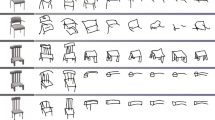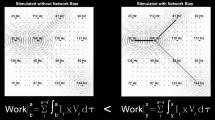Abstract
To study the development of graphical conventions, members of a simulated community were asked to play a series of graphical interaction games with partners drawn from the same pool. Once established, the community arrived at a set of conventional graphical referring expressions. The present paper offers a qualitative analysis of this interactive process, documenting the convergence and symbolization of participants’ initially iconic graphical productions. This global process is contrasted with the local process evident among pairs who interact in isolation. Consistent with an evolutionary perspective, I argue that the graphical conventions that evolved within the simulated community are optimized representations, developed via a dynamic, interactive process.
Preview
Unable to display preview. Download preview PDF.
Similar content being viewed by others
References
Chartrand, T.L., Bargh, J.A.: The chameleon effect: The perception-behavior link and social interaction. Journal of Personality and Social Psychology 76, 893–910 (1999)
Clark, H.H., Wilkes-Gibbs, D.: Referring as a collaborative process. Cognition 22, 1–39 (1986)
Fay, N., Garrod, S., Lee, J., Oberlander, J.: Understanding interactive graphical communication. In: Proceedings of the 25th Annual Conference of the Cognitive Science Society, pp. 384–389 (2003)
Fay, N., Garrod, S., MacLeod, T., Lee, J., Oberlander, J.: Design, adaptation and convention: The emergence of higher order graphical representations. In: Proceedings of the 26th Annual Conference of the Cognitive Science Society, pp. 411–416 (2004)
Garrod, S., Anderson, A.: Saying what you mean in dialogue: a study in conceptual and semantic co-ordination. Cognition 27, 181–218 (1987)
Garrod, S., Doherty, G.: Conversation, co-ordination and convention: an empirical investigation of how groups establish linguistic conventions. Cognition 53, 181–215 (1994)
Pickering, M., Garrod, S.: Towards a mechanistic theory of dialogue. Behavioral and Brain Sciences (in press)
Tversky, B.: Cognitive origins of graphic conventions. In: Marchese, F.T. (ed.) Understanding images, pp. 29–53. Springer, New York (1995)
Author information
Authors and Affiliations
Editor information
Rights and permissions
Copyright information
© 2007 Springer Berlin Heidelberg
About this paper
Cite this paper
Fay, N. (2007). The Emergence and Evolution of Graphical Productions. In: Sakurai, A., Hasida, K., Nitta, K. (eds) New Frontiers in Artificial Intelligence. JSAI JSAI 2003 2004. Lecture Notes in Computer Science(), vol 3609. Springer, Berlin, Heidelberg. https://doi.org/10.1007/978-3-540-71009-7_32
Download citation
DOI: https://doi.org/10.1007/978-3-540-71009-7_32
Published:
Publisher Name: Springer, Berlin, Heidelberg
Print ISBN: 978-3-540-71008-0
Online ISBN: 978-3-540-71009-7
eBook Packages: Computer ScienceComputer Science (R0)




